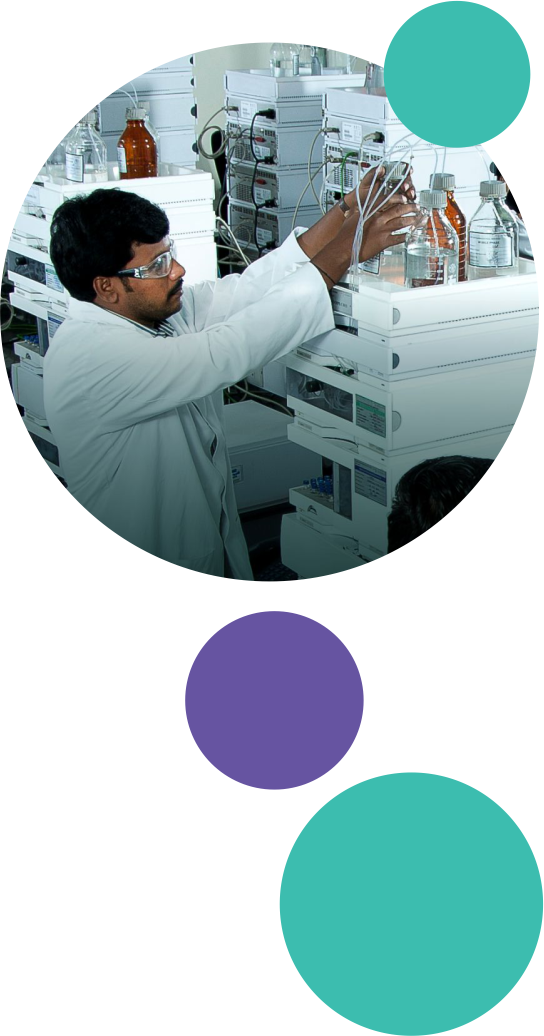|
|
| |
| |
| ENVIRONMENT PERFORMANCE |
| GREEN CHEMISTRY |
Chemistry lies at the heart of the drug discovery and development.
However, many of the chemicals used in the manufacturing
process are hazardous in nature. To address this issue, Dr.
Reddy's is accelerating the use of green chemistry toreduce or
eliminate the generation of hazardous substances. |
We have developed Green Chemistry metrics in association with
the American Chemical Society Green Chemistry Institute, to help
us monitor and manage various aspects of sustainability such as
atom efficiency, e-factor, reaction mass intensity and energy efficiency. |
We consistently implement these metrics to improve safety, health
and environmental performance, and to optimise resources,
conserve energy and enhance productivity.. |
| Green Premise |
| We have adopted 12 principles of Green Chemistry and engineering as described below. |
 |
Prevent waste |
 |
Maximise atom economy |
 |
Design safer chemicals and
products |
 |
Use safer solvents and reaction
conditions |
 |
Design less hazardous chemical
syntheses |
 |
Design chemicals and products to
degrade after use |
 |
Use renewable feedstock |
 |
Increase energy efficiency |
 |
Use catalysts, not stoichiometric
reagents |
 |
Real time analysis to prevent
pollution |
 |
Avoid chemical derivatives |
 |
Minimise the potential for accidents |
|
| |
| Green Progress |
| Sustainable Synthesis |
| |
In the reporting period, we fast-tracked our efforts in finding more sustainable means
of synthesis than traditional chemistry approaches. Following are some of the
improvements that we made to our processes during the reporting period. |
| Eslicarbazepine Acetate |
| Eslicarbazepine Acetate is considered to be a second generation drug to oxacarbazepine and a third generation drug to carbamazepine meant for treating epilepsy. It is adjudged as a prodrug to (S)-licarbazepine. |
| Eslicarbazepine acetate was evolved in order to have improved efficacy and safety, preventing the formation of toxic epoxide metabolite. The previously reported synthesis involved a resolution strategy, which, by design, yielded a maximum 50% conversion leaving behind almost same quantity of material as waste along with a significant quantity of liquid and solid effluents. We adopted an asymmetric reduction approach, which enhanced the yield to 80% and thereby avoided a significant amount of waste. Plus, it also made the manufacturing process more energy efficient. |
 |
|
The earlier process involved five steps and the overall yield was found to be 13% with a highly unfavourable E-factor of more than 800 kg. |
|
|
 |
|
The improved process involves three steps and 80% yield. E-factor has improved by almost 10 times (<88 kg). |
|
|
*Since E-factor has substantially improved, we adjudge our route greener than the current
one developed by the innovator/other manufacturers. |
|
|
| |
| Voriconazole |
| Voriconazole has become the new standard of care in the treatment of invasive aspergillosis, which may occur in immunocompromised patients, including allogeneic BMT, hematologic cancers, and solid organ transplants. |
| The previously reported synthesis involved a resolution strategy, which, by design, yielded a maximum 50% conversion leaving behind almost the same quantity of material as waste along with a significant quantity of liquid and solid effluents. |
| We adopted the dia stereo selective coupling approach giving relatively higher yields and selectivity. Eventually, a significant amount of waste has been avoided making the manufacturing process energy efficient. |
 |
|
The earlier process involved six steps and the overall yield was found to be 5.6% with a highly unfavourable E-factor. |
|
|
 |
|
The improved process involves six steps and 19.1% yield has been achieved. The E-factor has improved to 40 kg. |
|
|
* Since E-factor has substantially improved, we adjudge our route greener than the current
one developed by the innovator/other manufacturers. |
|
|
|
|
| |
| Pregabaline |
| ((S)-3-(Aminomethyl)-5-methylhexanoic acid ((S)-Pregabaline) is a 4-aminobutyric acid (GABA) analogue and is used as an anticonvulsant drug for the treatment of neuropathic pain, epilepsy, anxiety, and social phobia. |
| The previously reported synthesis involved a resolution strategy, which, by design, yielded a maximum 50% conversion leaving behind almost the same quantity of material as waste along with a significant quantity of liquid and solid effluents. |
| In our approach, we outsourced the advanced intermediate, considering recycling of undesired enantiomers, recovery of solvents and resolving agents at the vendor's site. Eventually, a significant amount of waste has been avoided making the process energy efficient. |
 |
|
The earlier process involved two steps at Dr. Reddy's manufacturing site and the overall yield was found to be similar with improved process. The process involved sodium hypobromide with an unfavourable E-factor. |
|
|
 |
|
The improved process involves two steps and a 64% yield for the two steps has been achieved. Sodium hypobromide was replaced with sodium hypochloride which helped us to reduce the E-factor close to 21 kg. |
|
|
* Since E-factor has substantially improved, we adjudge our route greener than the current
one developed by the innovator/other manufacturers. |
|
|
| |
| Prozole |
| The synthesis of sulphoxides from sulphides has been widely explored and numerous oxidants have been developed to achieve a facile, efficient and selective sulphoxidation during the synthesis of prozole family members. The greener procedure for the oxidation of sulphide intermediate involves the aqueous media and eco-friendly reagent sodium hypochlorite (NaOCl). In general, sodium hypochlorite mediated oxidation is widely explored in the sulphide to sulphoxide transformation. The method is efficient, versatile, and produces sulphoxides under mild conditions. . |
|
|
|
| |
| |
| |
| |
|
|




